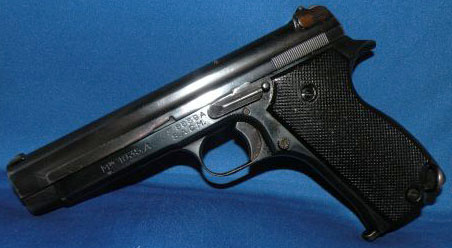|
French Modele 35A Pistol: The First Branch on the Developmental Tree By David Tong  French military surplus arms are neither common nor much collected on this side of the ocean. Mostly of somewhat eccentric design, the best known example is the MAS 1936 bolt-action rifle with its forward angled bolt handle. In addition, all French arms until 1950 utilized unique French-designed cartridges that have been relatively rare over here, though this was not an uncommon practice in those nationalistic days before modern collective alliances, such as NATO. The subject in question, the Mle. 1935A, was designed by a Swiss engineer, Charles Petter, who worked for �Engineering Societe Alsacienne de Constructions Mechaniques de Cholet, or �SACM� for short. It was adopted by the French Army in 1937, after a two year military trials process. Specifications:
The pistol is a modified Browning tilt-lock short recoil design, using the classic annular locking lugs as well as a double swinging link design. Charles Petter modified the 1911 design by eliminating the barrel bushing and recoil spring plug, instead using an integral bushing and full length guide rod for the recoil spring. However, Petter left a rather noteworthy design legacy in the 35A, which is the integrated fire control system module, removed as one unit. It contains the trigger, hammer, sear and mainspring assemblies. This unit construction technique was so admired that the design was licensed from SACM by Schweitzer Industrie Gesellschaft, better known by its acronym, �SiG.� That company reportedly consulted Charles Petter in their design of the Swiss service Pistole M1949, which is the commercial SiG P-210, one of the most admired postwar service pistols in the world. In addition, some Petter-inspired design ethos (though not used on the Mle. 35A), is visible in the P-210, which also used an integrated fire control module, as well as in the Czech CZ-75. Petter inspired the placement of the slide within the receiver�s rail tracks, which reverses the more prevalent Browning type of slide reciprocation outside of the receiver. The Mle. 35A is widely respected for its slim feel and handling characteristics. It points naturally, although it was apparent, even in 1937, that a 77 grain bullet traveling at 1,100 fps was not a powerhouse military sidearm. The sights are large and fairly visible for the era. The rear sight is machined directly into the slide without provision for adjustment. The pistol�s slide mounted manual safety is an oddity. Located at the left rear of the slide, it swings upward in a 90-degree arc to place the pistol on safe and a rotating element prevents the hammer from striking the rear of the firing pin. However, the safety does not disconnect the trigger, so some caution is recommended. The trigger can still be pulled and, while the hammer strike should not cause a discharge, it would be prudent to carry the piece on an empty chamber. Field stripping the pistol is simple. After removing the magazine via the usual Browning type left side push button and clearing the chamber, rack the slide approximately �� from battery to expose a disassembly notch, push the slide stop pin with your right index finger and remove the slide stop. Move the slide group forward and remove the spring, guide and barrel from below. Unlike the more familiar Browning Hi-Power or 1911, there is no need to align the recoil guide rod or the swinging links. When replacing the guide rod in its seat below the barrel, the links align automatically with the hole at the rear of the guide rod. Reassembly is thus a breeze. The French were able to build a tad over 10,000 pistols before the Germans overran the country in June, 1940. The Germans manufactured approximately 24,000 more as a substitute standard sidearms for their occupation police before the 1944 liberation. The French resumed production and build 50,000 more until 1950, when it was replaced by the Modele 1950 in 9x19 caliber. I wish that I had an opportunity to fire the pistol. The scarcity of the ammunition made this impossible. The pistol photographed above is being offered for sale at my local shop, Albany Guns in Oregon, with an original 96 round box of military hardball. Imported by Century Arms International of Georgia, Vermont, the country�s largest importer of surplus military arms, perhaps one can locate ammo by telephoning them. Recoil is said to be mild, as one might suspect from the ballistics of the cartridge. The experienced handloader can use a small table lathe to modify .32 S&W Long cartridge cases by turning off the rim, cutting an extraction groove and shortening the length to 22mm. I enjoy delving into the arcane history and technical development of the automatic service pistol. While the Mle. 35A was militarily a dead end, the legacy of Charles Petter lives on three-quarters of a century later. You read it here first. |